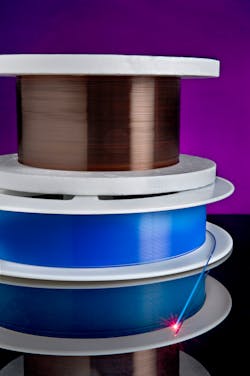
Optical fiber technology, which has been used in the clinic since the 1960s, offers a convenient, affordable, safe, and effective approach for delivering light to and from the tissue region of interest.1 Its advantages for clinical use are numerous: It is noninvasive to the patient, as it can come in contact with skin or surgically exposed surfaces, and it is flexible and has a thin outer diameter, so it can be inserted into the patient via endoscopy or intravascular positioning. What's more, it enables assessment of previously difficult-to-reach areas with more sensitivity, which is important for clinical use since it increases patient comfort. In research applications—cell sampling, biomedical instrumentation, and detailed analysis—it enables detection of ultrasmall drug molecules, virus particles, and DNA in a small sample volume.
"In many cases, it is important to customize the fiber specification for the application," says Bryce Samson, vice president, business development at Nufern (Granby, CT). In medical laser delivery, optical fibers guide light in laser ablation, tissue welding, and photodynamic therapy (PDT). For example, in laser ablation, optical fibers that can handle high powers, such as silica/silica and hard-clad fibers, are essential.
On the research side, optical fiber bundles with varying numerical apertures (NAs) can deliver multiple photons that emit from samples to the system's detectors. To that end, some optical fiber makers offer custom optical fiber bundles with varying NAs and fiber core sizes, depending upon needs. Cheryl Provost, scientific industrial sales engineer at CeramOptec (East Longmeadow, MA), says that the company is seeing an increase in requests for custom fibers and bundles for both diagnostic and treatment applications.
Trend watch
"Customers will continue to push boundaries of fibers, and quite frequently will need assemblies that consist of optomechanical and electro-optical components incorporating standard features with custom-configured fused silica and precision optical components," explains Robert Dauphinais, business development manager at Polymicro Technologies (Phoenix, AZ).
Steve Allen, medical market manager at OFS Specialty Photonics Division (Norcross, GA), notes that optical fibers are beginning to have smaller outer diameters, enabling their use in miniaturized optical fiber sensors such as disposable catheters. Further, he also notes the use of fiber Bragg gratings (a reflector created in the core of an optical fiber to reflect certain wavelengths of light while transmitting others) for sensing and imaging as a hot area, particularly in polymer optical fibers (POFs), as they are low-cost and integrate easily into pulse oximeters, body fat meters, and glucose monitors (see table).
Samson says that he is seeing more interest in the shortwave infrared (SWIR) wavelengths than ever before, partly due to the improvements in fiber-based sources at 2 μm with lower cost, higher power, and better performance than their solid-state alternatives.
Future outlook
"Growth will happen [in the optical fiber market] because society wants improved healthcare-better treatment-which ultimately reduces costs by reducing return patients, operating room time, and shortening patient healing," explains Allen. The industry will continue to grow, he explains, but probably at a slower rate than industry experts are currently predicting. "There is ample opportunity, with numerous emerging segments and applications, but not all will be successful—either because of market adoption and/or competing technologies not requiring fiber," he adds.
Dauphinais says that fiber manufacturers will continue to see more demanding performance criteria from customers, including lower loss products over a broader spectrum, which enable collection of more wavelengths of reflected light and, in turn, more information from the detectors on an optical fiber sensor. Precision optical fiber terminations and custom laser-based end shaping techniques will continue to be a future trend in the life sciences arena, he says, and Provost agrees: More people will request more complex fiber solutions to meet the requirements of an expanding market, and "new instrumentation for diagnostics/testing and new applications for less invasive treatment will continue to push the design process."
For Nufern, says Samson, the foreseeable future for optical fibers is a bright one. He claims that the company will see growth in all its major life sciences markets, with growth exceeding 20% per year.
REFERENCE
1. N. S. Kapany, Fiber optics; Principles and applications, Academic, New York, NY (1967).

Lee Dubay | Managing Editor
Lee Dubay is managing editor for Laser Focus World. She is a seasoned editor and content manager with 20 years of experience in B2B media. She specializes in digital/print content management, as well as website analytics, SEO, and social media engagement best practices.
